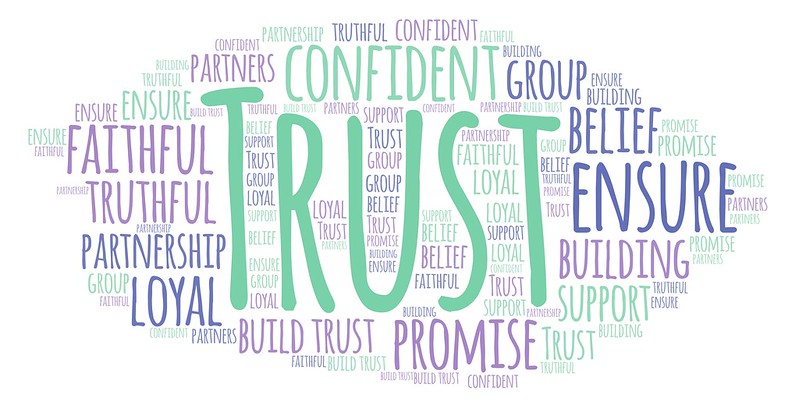
Often when working with organizations, I find that Trust is an issue that has to be addressed. We can’t function without at least a minimal level of trust. To get to high performance, trust levels between team members need to be higher than normal. But what does that mean?
A lack of trust is hard to talk about or pin down and even harder to know how to deal with.
We very rarely come right out and say, “I don’t trust X.” And when we do, it’s usually vague as to why. More often, this is seen through actions such as avoidance, taking over tasks, micromanagement, or variations of communication such as “I’m just not sure they’re up to the task” or “I’m not comfortable with…”
Understanding what we mean by Trust
First and foremost is that trust involves vulnerability. Trust is an internal perception. If I’m unwilling to invest, at least a little trust, there is no way for another to “earn” or “build” it. I must risk disappointment in order to trust others.
Further, trust is contextual. We trust friends and family with different things in our private life than we do with our colleagues at work. We have different expectations for people in different contexts and environments.
In order to improve the conversation, I look to psychologist and researcher K. Giffin’s1 definition of trust as a person’s perceptions of another’s :
- Skills and Knowledge
- Follow-through
- Good intentions
This helps me pull apart some important aspects of Trust and understand how to deal with each separately.
Problems often arise when we feel disappointed after having given too much initial trust.
Here I find it useful to identify which area we’ve over-extended trust so we can take a useful corrective action. In general, the first step is always to establish safety.
Skills and Knowledge
When perception of other people’s skills and knowledge is the issue, we want to establish safety by first pulling back expectations and consequences to a safe level. For instance, if I’ve shown a lack of skills around driving a car, it’s best for me to have a safe place to practice that isn’t putting others in danger. In our day-to-day work, we need to find the right level of autonomy that safely matches our skills and knowledge.
We need an environment that allows us to safely learn and grow. In software, this happens through ensemble programming or pairing, good technical practices, etc.
In order to gain trust from others and establish greater autonomy, we have to show competency. As we show competency, leaders should give more control.
Follow-through
When follow-through is the issue, we establish safety by first checking our agreements.
It may be that one party didn’t actually agree in the first place. I’ve seen situations where a team “agrees” to do work when their manager says it will get done in a meeting that none of them attended. Assignment and agreement are different things.
Another common cause of misunderstanding is lack of clarity on an agreement. With any agreement, it’s important to establish what in contracting is known as a “meeting of the minds” - if the parties involved didn’t have a mutual understanding of terms, there isn’t a valid agreement.
We achieve this by making agreements explicit by stating expectations of visible, confirmable effects. Once we’ve established that we have a true agreement, we should make it visible so that it’s easy to point to and bring into the conversation.
Once we’ve done these things, we can more easily have honest accountability.
High-performance teams can rely on each other to follow through.
Good Intent
In business situations, it’s rare to find truly bad intent. Most people see themselves as the hero of their own story and are trying to do the right thing. When we have a perception that someone lacks good intent, it is more often related to misunderstanding and conflicting goals than truly nefarious actions.
Most situations can be solved by getting curious. Find out what is important to others and why their actions make sense from their perspective. You may need to sort out priorities, you may find they have a different goal, or maybe you’ll learn of a risk that is obvious to them but overlooked by you. In any case, building trust begins by building understanding.
If someone is discovered to actually harbor bad intentions toward you or the group, first isolate and insulate. They should be removed from the context. If you don’t feel you have the authority to do so, then escalate and ask for intervention.
More trust through better communication
Hopefully, this has provided a framework for people to have better conversations around Trust.
The next time you find yourself in a situation where trust is an issue, what might you ask?
What might you do differently?
Special thanks to Esther Derby, Tim Ottinger, and Sandra Browne for feedback, helping edit, and nudges to get this piece to a publishable point.
Related Discussion:
We had an open discussion through our Industrial Logic TwitterSpace. Here is the recording of that conversation.
Notes
Image by Epic Top 10 Site
-
Giffin, K. (1967). The contribution of studies of source credibility to a theory of interpersonal trust in the communication process. Psychological bulletin, 68(2), 104. ↩




